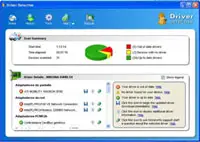
For computer hardware and software to interact properly, a program, or device driver, is installed and provides configuration details that allow the devices to work together. For example, simply connecting a printer to a computer may not work. Most Windows operating systems will auto-detect the new printer and often auto-install the driver for the new printer as well. Only after the driver is installed will the printer work on the computer.
While Microsoft Windows operating systems generally detect most drivers, software programs have been developed to make the process easier as well. Driver update programs are used to scan the computer and detect, download, and install any required drivers that are missing, corrupt, or outdated.
What needs a driver?
Usually, any hardware that is connected will need a driver or configuration file of some kind. Common pieces of hardware that require drivers:
- Motherboard
- Video card
- Sound card
- Hard drives
- Mouse/keyboard (in some cases)
- Printer/scanner
- Webcam
- And many other pieces of hardware that are connected to your computer
After a driver is properly installed, the device is ‘synched’ with the computer. Additional configuration settings may be required, but the device should function as designed after a driver is installed and updated.
How Do Driver Update Programs Work?

The first thing a driver update program will do is scan the computer in detail. The scan will detect device information, driver data, and should be able to determine which drivers or devices require a new file or an updated version.
Driver update tools have databases of driver files for devices and vendors. Some applications have drivers for more than 50,000 devices and upwards of 10 million individual driver files.
With an extensive database, the program can scan the computer to gather device and driver information about hardware and software. After verifying versions or dates of files, the program can then install drivers that are missing or corrupt, and update drivers that may be outdated.
Some programs use software from a variety of sources, while reliable programs will stick to drivers and files from OEM (original equipment manufacturer) sources.
Additionally, having detailed feedback or commenting systems also helps keep the software as effective as possible, by allowing users to provide information about any errors or improper driver installations.
What can happen if a computer is using outdated drivers?
As with all software on your computer, it is strongly recommended to keep drivers updated. The operating system, any applications that are installed, and definitely hardware/firmware drivers should be updated as necessary. The primary risk of using outdated drivers is lack of compatibility and/or possible functionality restrictions.
 Updates are most frequently released for functional or security reasons than for new features, although that is sometimes an added benefit. Be sure to update your drivers, and if you are having trouble doing so manually, use a driver update tool to help.
Updates are most frequently released for functional or security reasons than for new features, although that is sometimes an added benefit. Be sure to update your drivers, and if you are having trouble doing so manually, use a driver update tool to help.
Benefits of Using Driver Update Programs
Many benefits exist, and depending on how comfortable you are managing specific applications or files on a computer, using a driver update program may save a lot of time and trouble as well. Here is a list of benefits you may notice while using a program to help update your drivers.
- Saves time – Since the program can scan devices and detect those needing new drivers, download any necessary drivers, and install them as well, it can make the entire process quick and easy.
- Provides security – It may not be security in the sense that your system is at risk, but it may protect your hardware from damage by using less-than-optimal settings.
- Functional improvements – With the newest firmware/drivers, your system can perform as it was meant to. This means, given the proper compatibility, your computer will properly recognize the hardware and be able to utilize all RAM that is installed.
- Saves money – As outlined in number 3, users may think they need to update their hardware when really a driver update is all that is required. Depending on the hardware, this could save hundreds of dollars.
Users with less experience installing and updating drivers will benefit most with the help of an application like this.
Downsides of using Driver Update Applications
Driver update software is not for everyone. As with most software, some programs have more negatives than positives. Regardless, here are a few reasons why you may not want to use a program to help update your drivers.
- Wrong drivers – Driver programs may install the wrong drivers. Whether incorrectly recognizing hardware or actually downloading and installing improper drivers, certain applications may not recognize the correct driver for the individual hardware.
- Missing drivers – As the software requires a database of drivers, it may become outdated or miss important drivers. Some reviews claim driver programs can miss 10% or more of necessary drivers during a scan, download, and install.
- License fees – While having the correct driver can help save money, having a program to find the right drivers for your system can cost money. License fees are generally per year, and in the ballpark of $30 to $50.
If you are unsure of which drivers to use, a program can definitely help you. However, if you do have experience on your system and understand which hardware needs drivers and where to get those drivers, it may not be worth your money to buy a software program to help.
Top 3 Recommended Driver Update Programs
Take a look at more information about a few programs that can help you find drivers for your system.
- Driver Detective
- Driver Genius Professional
- DriverCure
For additional information on driver update software, see our reviews.

